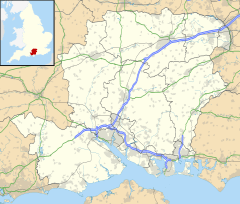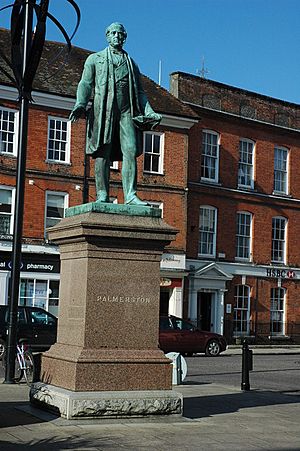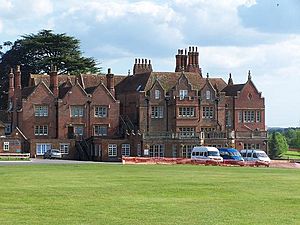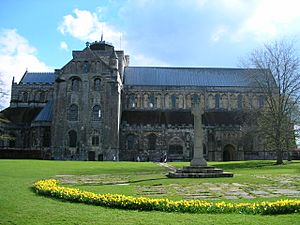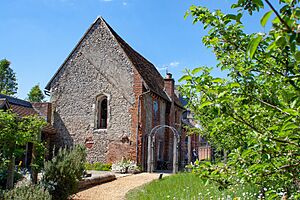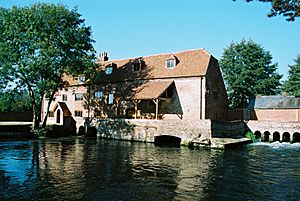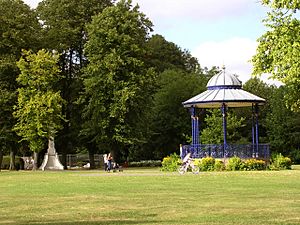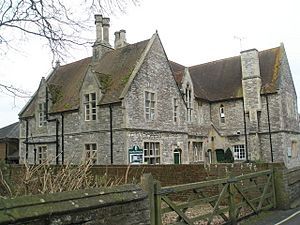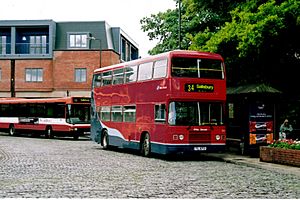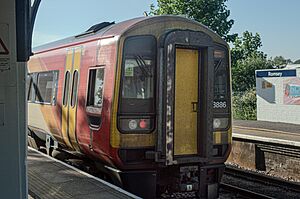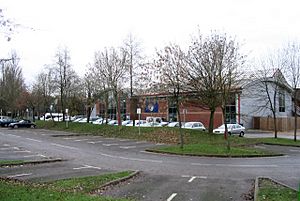Romsey facts for kids
Quick facts for kids Romsey |
|
|---|---|
| Market town | |
 Romsey Corn Exchange |
|
| Population | 14,768 (2011 census, parish) |
| District |
|
| Shire county | |
| Region | |
| Country | England |
| Sovereign state | United Kingdom |
| Post town | ROMSEY |
| Postcode district | SO51 |
| Dialling code | 01794 |
| Police | Hampshire |
| Fire | Hampshire |
| Ambulance | South Central |
| EU Parliament | South East England |
| UK Parliament |
|
| Website | Romsey Town Council |
Romsey (/ˈrɒmzi/ ROM-zee) is a town in the Test Valley district of Hampshire, England. The town is situated 7 miles (11 km) northwest of Southampton, 11 miles (18 km) southwest of Winchester and 17 miles (27 km) southeast of Salisbury. It sits on the outskirts of the New Forest, just over 3 miles (4.8 km) northeast of its eastern edge. The population of Romsey was 14,768 at the 2011 census.
Romsey is one of the principal towns in the Test Valley Borough and lies on the River Test, which is known for fly fishing, predominantly trout. In 2019, the town centre underwent substantial remodelling, removing the roundabout around the statue of Lord Palmerston, and creating a pedestrianised area.
Romsey was home to the 17th-century philosopher and economist William Petty and the 19th-century British prime minister, Lord Palmerston, whose statue has stood in the town centre since 1857. The town was also home to the 20th-century naval officer and statesman Louis Mountbatten, 1st Earl Mountbatten of Burma, who lived at Broadlands. Romsey Abbey, the largest parish church in Hampshire, dominates the centre of the town. Other notable buildings include a 13th-century hunting lodge, an 18th-century coaching inn and the 19th-century corn exchange.
Contents
History
Middle Ages to the Civil War
The name Romsey is believed to have originated from the term Rūm's Eg, meaning "Rūm's area surrounded by marsh". Rūm is probably an abbreviated form of a personal name, like Rūmwald (glorious leader).
What was to become Romsey Abbey was founded in 907.
The village swelled alongside the religious community. The Vikings sacked Romsey in 993, burning down the church. But the village recovered, and the abbey was rebuilt in stone in about 1000. The religious community flourished as a seat of learning, especially for the children of the nobility. A market was established outside the abbey gates.
The Domesday Book of 1086, which identifies three mills in the village, provides the earliest record of the Watermills which have played a part in Romsey's history as an industrial town.
The body of King William II "Rufus" was carried through Bell Street in Romsey on its way to Winchester, after he had been killed whilst hunting in the New Forest.
The Normans built the large current abbey that dominates the town (between c. 1120 and 1140) on the site of the original Saxon church. By 1240, 100 nuns lived in the convent.
King Henry I granted Romsey its first charter. This allowed a market to be held every Sunday, and a four-day annual fair in May. In the 13th century, Henry III permitted an additional fair in October.
The lucrative woollen industry appears to have powered Romsey's growth during the Middle Ages. Wool was woven and then fulled or pounded with wooden hammers whilst being washed. It was dyed, and then exported from nearby Southampton.
Romsey continued to grow and prosper until plague struck the town in 1348-9. The Black Death is thought to have killed up to half of the Romsey's population of 1,000. The number of nuns fell as low as 19. Prosperity never returned to the abbey. It was finally suppressed by Henry VIII during the Dissolution of the Monasteries in 1539. Many religious buildings were destroyed around this time. The abbey itself was saved from demolition because part of it was a parish church for the people of Romsey. The town purchased the abbey from The Crown for £100 in 1544. The part of the abbey that had saved the abbey, the church of St Lawrence, was demolished.
By the mid-16th century Romsey's population was about 1,500; its woollen and tanning industries fuelled growth. On 6 April 1607 King James I granted the town a charter making it a borough. This gave official status to an informal local government that had been running the affairs of the town since the Dissolution of Romsey Abbey in 1539. Romsey could now have a corporation comprising a mayor, six aldermen and twelve chief burgesses, with a town clerk for 'office work'. Furthermore, there was to be a local law court under a Court Recorder, assisted by two sergeants-at-mace. Over all, was the position of High Steward, the first of whom was the Earl of Southampton.
Romsey changed hands several times during the English Civil War. Both Royalist and Parliamentary or Roundhead troops occupied and plundered the town. Royalists remained in control of the borough until January 1645.
18th to 20th centuries
The town's woollen industry survived until the middle of the 18th century, but was beaten by competition from the north of England. However, new fast-growing enterprises soon filled the gap with brewing, papermaking and sackmaking, all reliant upon water from the Test.
During the 19th and early 20th centuries Romsey became notable for making collapsible boats, invented by the Rev. Edward Lyon Berthon in 1851. The Berthon Boatyard in Romsey made the boats from 1870 until 1917. They were used as lifeboats on ocean-going liners.
By 1794 a canal connected Romsey to Redbridge – at the mouth of the River Test – and Andover to the north but within 50 years had largely fallen into disuse. Industry continued to grow. Romsey was a reasonably large town for the early 19th century: its population was 4,274 in the first census of 1801, compared with just 8,000 for Southampton.
Despite the arrival of the railway in 1847 the expansion slowed and whilst its population had grown to 5,654 in 1851 it then stagnated and by the time of the census half a century later (1901) the population was just 5,597.
Lord Palmerston, the 19th-century British Prime Minister, lived at Broadlands, a large country estate on the outskirts of the town. His statue, by sculptor Matthew Noble, stands in the Market Place outside the Town Hall.
The Willis Fleming family of North Stoneham Park were major landowners at Romsey from the 17th until early 20th centuries, and were lords of the manors of Romsey Infra and Romsey Extra.
Broadlands later became the home of Lord Mountbatten of Burma, known locally as "Lord Louis". In 1947, Mountbatten was given his earldom and the lesser title "Baron Romsey, of Romsey in the County of Southampton". Queen Elizabeth II's husband, Prince Philip, was his nephew and upon Philip's marriage to Elizabeth in 1947 they departed London for their honeymoon at Broadlands.
Mountbatten was buried in Romsey Abbey after being killed in an IRA bomb explosion in Ireland on 27 August 1979. After his death his titles passed to his elder daughter, Lady Brabourne, who thus became Lady Mountbatten of Burma. Her eldest son was styled by the courtesy title "Lord Romsey" until he inherited the title of Lord Brabourne in 2005.
Like his parents, Charles, Prince of Wales and his first wife Diana, Princess of Wales spent the first part of their honeymoon at Broadlands in 1981.
Embley Park, a country estate located on the outskirts of Romsey was the home of Florence Nightingale, known for her pioneering work as a nurse and sanitary reform during the Crimean war and for laying the foundation of modern nursing. Nightingale is said to have had her calling from God whilst sitting under a giant cedar tree in the grounds of Embley Park on 7 February 1837. The site is now home to a private school.
Nightingale is buried in the family vault at St. Margaret Church in East Wellow, located on the outskirts of Romsey.
During 2007 Romsey celebrated the 400th Anniversary of the granting of its Charter by King James I with a programme of events from March through September, including a visit on 8 June from the Queen and the Duke of Edinburgh. Subsequently. the cost of the visit has created some local political controversy.
Present
Whilst heavy industry in the town has declined, three industrial and trading estates focus mainly on service industries and small-scale manufacturing. Three scientific and high technology employers – Roke manor research, Southampton Science Park and IBM – have establishments nearby.
The town centre contains a Waitrose supermarket, an independent department store (Bradbeers), and other retail outlets, including high street chains and independent shops.
Governance
Romsey is part of the Romsey and Southampton North parliamentary constituency. Its current MP is Caroline Nokes of the Conservative Party. Elected in the general election on 6 May 2010, after boundary changes, she defeated the Liberal Democrat MP Sandra Gidley with a 4.5% swing to Conservative from Liberal Democrat and a majority of 4,156 votes. Gidley had held the seat since a by-election in 2000 in the former Romsey seat.
The town is part of the Test Valley district council which is controlled by the Conservative Party. Norton Knatchbull, 3rd Earl Mountbatten of Burma, grandson of Louis Mountbatten, 1st Earl Mountbatten of Burma, is the current High Steward, a position which dates from the 17th century (see above).
Romsey Town Council holds its meetings and has its offices at Romsey Town Hall.
Places of interest
Romsey Abbey
Romsey Abbey is a 12th-century abbey built in the Norman style, probably by Henry of Blois, upon an earlier Saxon church dating back to the 10th century. Elements of the old Saxon church remain, including an exposed north transept and a 10th-century rood. The current abbey is the largest parish church in Hampshire and is generally regarded as cathedral-like by architects and observers. It is open daily to visitors.
Broadlands
Broadlands is an 18th-century country house located just outside the town centre. It was designed in the Palladian style by the famous architect Capability Brown before being completed by Henry Holland in 1788. It has had a number of illustrious occupants, including Lord Palmerston and Louis Mountbatten. Broadlands has been the setting of two royal honeymoons, namely those of Elizabeth II and Prince Philip in 1947 and then Prince Charles and Princess Diana in 1981. The house itself is a Grade I listed building and the surrounding gardens are Grade II listed on the Register of Historic Parks and Gardens. Both are open to visitors on weekday afternoons in summer.
King John's House
King John's House is a 13th-century building that allegedly served as a hunting lodge for King John when he hunted in the nearby New Forest. This is unlikely, however, since it was built in 1256 and therefore 40 years after the king's death, though there is evidence that the beams were reused from an earlier structure. The original building and adjoining Tudor cottage have a number of unusual historical features, including 14th-century wall decorations and graffiti, a floor made from cattle metapodials, and a traditional monastic garden. Locals claim the house is haunted, with the Hampshire Ghost Society encountering a shrouded figure during their investigations between 2002 and 2008. The house is a Grade I listed building.
Embley Park
Embley Park, a country estate located on the outskirts of Romsey, was the home of Florence Nightingale from 1825 to her death in 1910. Known as the founder of modern nursing and for her work in sanitary reform, Nightingale is said to have received her calling from God in 1837 whilst sitting beneath a large cedar tree on the grounds. While a manor in Embley belonged to Romsey Abbey as early as the 10th century, the current building is of 18th- and 19th-century origin. The site is now home to Embley, an independent school. It is a Grade II listed building.
The White Horse Hotel
The White Horse Hotel is a Grade II listed, 18th-century coaching inn whose timber frames date back to the 1450s. Its medieval stone cellars indicate that the site may have hosted guests to Romsey Abbey as early as the 12th century. The existing assembly rooms are said to be where Lord Palmerston first engaged in political debate in the early 1800s. The building housed a hotel and brasserie, which until 2019, was owned and operated by Silks Hotels.
Sadler's Mill
The existence of Sadler's Mill, the only mill to be developed on the main course of the River Test, is first recorded in the 16th century, when it functioned as a corn and grist mill. It was at one time owned by Lord Palmerston and later the Broadlands estate before passing to various private owners. Milling ceased in 1932 and the building was left derelict for many years until its restoration in 2005. Carbon dating during this restoration placed the earlier structure in the mid-17th century. It is a Grade II listed building.
The Plaza
The Plaza, in Winchester Road, is a fully equipped 230-seat art deco style theatre, originally built as a cinema in the 1930s. It became a bingo hall until the 1980s. It was converted in 1984 and is now home to local amateur dramatics group, Romsey Amateur Operatic and Dramatic Society (RAODS), who stage between ten and fourteen productions each year and hire the venue out for other local productions, concerts, and functions.
Memorial Park
The town's memorial park, which plays host to the annual Mayor's Picnic, contains a Japanese Type 96 15 cm howitzer, one of two captured by the British and brought back to Romsey by Louis Mountbatten. One was donated to the town and the other retained on the grounds of his country estate, Broadlands.
Romsey signal box
Built in 1865, the signal box controlled the freight and passenger trains running on the railway lines passing through Romsey until 1982. Rescued from demolition by Romsey and District Buildings Preservation Trust, it is now a working museum.
Other places of interest
- Sir Harold Hillier Gardens – Gardens and arboretum
- Mottisfont Abbey – National Trust property with nationally renowned rose collection
- Paultons Park – Children's theme park
Events
The Mayor's Picnic takes place in early-mid summer and is held in Romsey's Memorial Park. There is music performed by local schools, a variety of stalls, and the popular Duck Race, in which numbered plastic ducks 'race' each other along the river Test, to be scrupulously retrieved before awarding a prize to whoever chose the winning duck.
The Beggars Fair is held in the streets and pubs of Romsey on the second Saturday in July. It is a free festival featuring all types of music, together with dance and other street entertainment.
Romsey Carnival takes place during a week in July with the highlight being the procession through the streets of Romsey on the final Sunday afternoon.
The Romsey Agricultural & Horse Show is a large agricultural show that takes place on the second Saturday of September every year at Broadlands. The show is one of the oldest in England, held annually since 1842. In addition, Broadlands has twice hosted the CLA Game Fair, the largest countryside show in the world, most recently in July 2006.
The Winter Carnival takes places each year when Romsey's Christmas lights are switched on.
The Romsey Arts Festival occurs every 3 years, showcasing talent from in and around the local area.
Romsey Beer Festival is organised by the local Round Table, and takes place in October or November each year, at Crosfield Hall.
Romsey has two Rotary Clubs which are active, working with local business partners and schools to raise charitable funds for the community. The Rotary Clubs organise the annual Walk The Test Way which has become popular with several hundred walkers raising money for charities.
Notable people
- Reverend W. Awdry – clergyman, railway enthusiast and author of The Railway Series from which the character Thomas the Tank Engine originated
- Edward Lyon Berthon – inventor and clergyman
- Charles Butler – author of children's books
- Martin Butler – composer
- Laura Carmichael – actress in Downton Abbey
- Andy Cook – footballer
- Harry Dennis – footballer
- Charlie Dimmock – TV gardening expert and presenter
- David Gower – retired cricketer and television personality
- Anthony Hayward – journalist and author
- Giles Jacob – legal writer and lexicographer
- John Latham – ornithologist and author
- Ollie Locke – featured in Made in Chelsea and Celebrity Big Brother 2014
- Ben Mansfield – actor
- Louis Mountbatten, 1st Earl Mountbatten of Burma lived at Broadlands
- Florence Nightingale – founder of modern nursing
- Lord Palmerston – statesman and Prime Minister
- William Petty – economist, philosopher and co-founder of the Royal Society
- James Robertson-Justice - actor
- John Russell Reynolds – neurologist and physician to Queen Victoria
- Richard Sharp – banker and Member of Parliament
- Tim Sills – footballer
- Nigel Spackman – footballer
- Kerrie Taylor – actress
Education
Former schools
In around 1850, Osborne House School, located in Church Street, was established by John Frederick Osborne, who was a councillor as well as headmaster. In 1877, he was mayor of Romsey. It closed for a few years after his death, reopening in 1904 under the same name, owned by William Summers, who was the headmaster. It was a boarding school and offered "Special attention... to backward pupils and to those requiring preparation for business or professional life", including preparation for entrance to London University (Summers' alma mater), Oxford, and Cambridge", as well as other examinations. Summers died during World War II, and it started to be used by the council as an overflow for council schools and as a centre for school dinners at some point. It was demolished in the 1960s and new buildings erected on the site. Osborne House School stood on the site of present-day Abbey Walk. During the 1920s, secondary school boys continued to wear shorts.
Gilbert Percy Whitley, later an ichthyologist and curator of fishes at the Australian Museum in Sydney for about 40 years, attended Osborne House School.
Present-day
Present-day schools include:
State primary:
- Braishfield School
- Cupernham Infant School
- Cupernham Junior School
- Halterworth Primary School
- Romsey Primary School
- Romsey Abbey C of E Primary School
Independent primary:
- Stroud School
- Embley
State secondary:
- The Mountbatten School
- The Romsey School
Independent secondary:
- Embley
Transport
Romsey is within 10 miles (16 km) of both the M27 and M3 motorways, providing fast links along the south coast and to London, and to the Midlands and the North via the A34. The A36 runs a few miles west of the town, providing a direct but not particularly quick route to the West of England and South Wales. There are cycle links to Southampton and Salisbury via route 24 of the National Cycle Network.
Romsey has a railway station, managed by South Western Railway, which provides services between Salisbury and Romsey, via Southampton and Eastleigh. The station is also served by services on Great Western Railway, operating services between Cardiff and Portsmouth, via Salisbury, Bath, Bristol, Southampton and Fareham.
A dedicated shuttle bus linking Romsey with fast London trains at Winchester was discontinued in 2009 despite a campaign to save the service.
Current bus services are provided by Bluestar within the town, as well as to Southampton and Eastleigh, Salisbury Reds to Salisbury and Southampton, as well as Stagecoach to Winchester.
Sport and leisure
One of the cricket clubs is Old Tauntonians and Romsey Cricket Club.
The Wessex League football club Romsey Town FC play at The Bypass Ground, South Front.
Romsey Rugby Football Club is based at Ganger Farm. It fields teams of all ages each weekend of the playing season.
The town has a swimming pool, the Romsey Rapids.
Media
Published every Friday, The Romsey Advertiser is the town's newspaper printed at Redbridge, Southampton.
Media appearances
In Thomas Hardy's Wessex, the town of Deansleigh is based on Romsey; and Deansleigh Park, the residence of Lady Mottisfont in A Group of Noble Dames, is thought to be based on Broadlands.
In the 1980 and 1990s, Romsey was used as the location of fictional Sussex town Kingsmarkham in the television series The Ruth Rendell Mysteries. Romsey locations appear throughout the series concerning Inspector Wexford played by George Baker. The location used for the fictional police station was the former Romsey Magistrates' Court in Church Street.
A fictional "underground car park in Romsey" is referred to in an episode of the TV series Absolutely Fabulous.
Freedom of the Borough
The following people and military units have received the Freedom of the Borough of Romsey.
Individuals
- Admiral of the Fleet Louis Mountbatten, 1st Earl Mountbatten of Burma: 1946.
Military Units
- The Royal Hampshire Regiment: 26 September 1959.
- The Princess of Wales's Royal Regiment inherited the Freedom from the Royal Hampshire Regiment as a result of the 1992 Options for Change merger with the Queen's Regiment.
See also
 In Spanish: Romsey para niños
In Spanish: Romsey para niños


